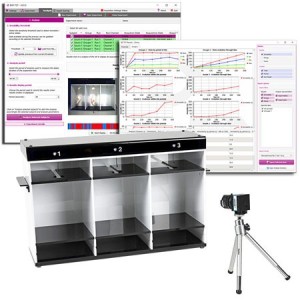Authors
J. F. Cryan, C. Mombereau, A. Vassout.
Lab
Psychiatry Program, Neuroscience Research, The Novartis Institutes for BioMedical Research WSJ 386.344, Novartis Pharma AG., CH-4002 Basel, Switzerland
Journal
Neuroscience & Biobehavioral Reviews
Abstract
Since its introduction almost 20 years ago, the tail suspension test has become one of the most widely used models for assessing antidepressant-like activity in mice. The test is based on the fact that animals subjected to the short-term, inescapable stress of being suspended by their tail, will develop an immobile posture. Various antidepressant medications reverse the immobility and promote the occurrence of escape-related behaviour. This review focuses on the utility this test as part of a research program aimed at understanding the mechanism of action of antidepressants. We discuss the inherent difficulties in modeling depression in rodents. We describe how the tail suspension differs from the closely related forced swim test. Further, we address some key issues associated with using the TST as a model of antidepressant action. We discuss issues regarding whether it satisfies criteria to be a valid model for assessing depression-related behavioural traits. We elaborate on the tests' ease of use, strain differences observed in the test and gender effects in the test. We focus on the utility of the test for genetic analysis. Furthermore, we discuss the concept of whether immobility maybe a behavioural trait relevant to depression. All of the available pharmacological data using the test in genetically modified mice is collated. Special attention is given to selective breeding programs such as the Rouen 'depressed' mice which have been bred for high and low immobility in the tail suspension test. We provide an extensive pooling of the pharmacological studies published to date using the test. Finally, we provide novel pharmacological validation of an automated system (Bioseb) for assessing immobility. Taken together, we conclude that the tail suspension test is a useful test for assessing the behavioural effects of antidepressant compounds and other pharmacological and genetic manipulations relevant to depression.
BIOSEB Instruments Used
Tail Suspension Test - Wireless (BIO-TST5)
Source :
http://www.sciencedirect.com/science/article/pii/S0149763405000382

 Pain - Thermal Allodynia / Hyperalgesia
Pain - Thermal Allodynia / Hyperalgesia Pain - Spontaneous Pain - Postural Deficit
Pain - Spontaneous Pain - Postural Deficit Pain - Mechanical Allodynia / Hyperalgesia
Pain - Mechanical Allodynia / Hyperalgesia Learning/Memory - Attention - Addiction
Learning/Memory - Attention - Addiction Physiology & Respiratory Research
Physiology & Respiratory Research











![Dynamic Weight Bearing 2.0 – Postural Module [Add-on]](https://bioseb.com/733-home_default/dynamic-weight-bearing-20-add-on-postural-module.jpg)
























 Pain
Pain Central Nervous System (CNS)
Central Nervous System (CNS) Neurodegeneration
Neurodegeneration Sensory system
Sensory system Motor control
Motor control Mood Disorders
Mood Disorders Other disorders
Other disorders Muscular system
Muscular system Joints
Joints Metabolism
Metabolism Cross-disciplinary subjects
Cross-disciplinary subjects CONFERENCES & MEETINGS
CONFERENCES & MEETINGS 